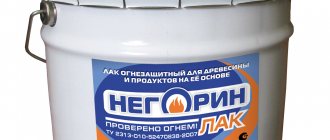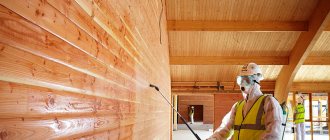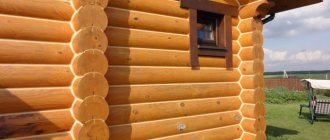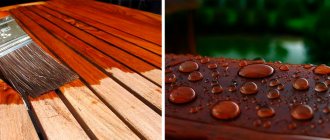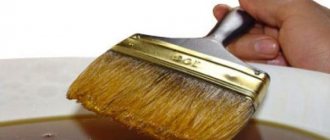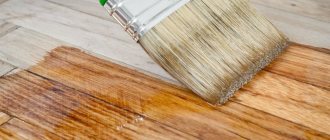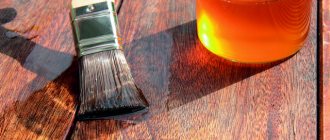Varieties of drying oil
The main component of most types of product is vegetable oil, to which solvents and technical additives can be added. Now analogues of drying oil are also produced from acrylic resins and polymer components.
Natural
According to GOST, drying oil must contain at least 97% natural oil. Most often, linseed oil is used for production, less often - sunflower, soybean, hemp or mixtures of several varieties.
The raw material first undergoes prolonged heating (about half a day) at high temperature, and then air blowing. Drying agents may be added to the composition. The finished product is opaque, has a faint smell of raw materials, and an oily consistency. It is used for priming wooden and metal surfaces, preparing paints, putties and putty mixtures, as well as for protective and decorative treatment of wood.
Drying oils made from linseed and hemp oils have the best strength, moisture resistance, and relatively quick drying properties. The first has a light color, and the second is dark and rich.
Semi-natural
This product is also called oxol. The oil in it takes up a little more than half of the composition. It is subjected to oxidation, a solvent (usually white spirit) and driers are added.
The production of such drying oil is cheaper, but it is not much different from natural in terms of performance.
A large percentage of solvent causes the product to have a pungent odor, which is why it is usually purchased for outdoor use.
The composition based on linseed oil has the greatest film strength and durability.
Combined
The combined product differs from the semi-natural one in its lower solvent content (about 30%). During the production of this drying oil, the oil polymerizes. It dries quite quickly (maximum 24 hours) and is used for the manufacture of thickly rubbed coloring compositions.
Synthetic
Drying oils based on petroleum products are inexpensive to produce and therefore have become widespread. Unlike natural impregnations, the composition and manufacturing process of such materials are not regulated by state standards, so they can vary greatly depending on the company. Compared to oil products, synthetic ones are much more transparent and have an unpleasant odor.
The most common drying oils in this category are slate and ethinol. The first has a dark color and is resistant to weather factors, so it is often used for facade finishing when tinting the paint in a dark color or diluting it to the desired consistency. It cannot be used to work with floor coverings and household items. Ethanol is light in color and has a strong odor. It is made from waste from the production of synthetic rubber. The coating dries quickly, is hard, and tolerates aggressive chemical agents well, but poorly with precipitation. The product is usually used as an additive to other types of drying oils (up to 10-15%), as well as for the production of coloring compositions and primers for metal.
Compositional
Drying oil is made from a mixture of oil and artificial components . Like a number of synthetic drying oils, such products often have unsatisfactory performance. For example, compositions made from oil sediment are incapable of drying normally, so it will not be possible to apply paint to the surface treated with them.
Oil-rubber drying oil is used as a base for paint.
When purchasing drying oil, you need to pay attention to the list of ingredients and technical specifications.
Use of semi-natural, combined and synthetic
Semi-natural products that have a light brown color are distinguished by a fairly high degree of hardness, strength, water resistance and have a good shine. Used as an impregnating agent or for priming various wooden surfaces (except floor coverings). Semi-natural compositions are used in conjunction with other paints and varnishes.
Combined products are produced with the introduction of various modifiers that improve their impregnation properties, which are necessary for the production and dilution of various thick paints. Used for priming various wooden products before their subsequent painting or plastering.
Since natural wooden surfaces impregnated with drying oil take at least 24 hours to dry, paint or plaster should not be applied until they are completely dry.
Synthetic drying oils are used in modern construction for diluting thickly rubbed paints and applying them to wooden surfaces. They are also used in industry for the production of various types of wood putties and pastes.
Criterias of choice
For exterior work, you can use synthetic drying oil, for interior use only natural
. First you need to decide on the type of drying oil used : for interior work, household items, products with increased environmental requirements, a natural product is suitable, and for facade primers and paints, you can also use options containing solvent .
The compositions of Russian manufacturers must be marked with GOST, and the list of components must not contradict it. If ingredients that are not typical for the desired class of product are indicated, you should not purchase drying oil.
The composition should have a color characteristic of the oil used and a uniform consistency. It should be opaque, free of sediment and any foreign inclusions. Natural products have a pleasant oily smell, but oxol smells like a solvent.
Natural materials
To ensure 100% environmental friendliness in home improvement, you need not only to use natural material - wood, but also safe materials for its processing.
Natural drying oil does not contain solvents, but is made from drying and/or semi-drying vegetable oils through deep processing.
Surface treatment rules
Since drying oil is a fire hazard, it is necessary to ensure good ventilation in the room where it will be applied. This can be ventilation or a system with forced air flow and explosion-proof design.
Consumption
For natural impregnation applied in one layer, the consumption per 1 m² of area will be about 100-120 g . Oxol gives a slightly lower indicator. Drying oil is applied in 2-3 layers, each of which must be thoroughly dried.
Question to the expert
How can you dilute drying oil?
If the drying oil has become too thick, you can add a solvent (about 5-10%) into it. White spirit is most often used for this. The composition should not be too liquid.
Application
It is recommended to carry out work at temperatures above +15 degrees. Dust and dirt must be removed from the surface to be treated. Then it is degreased and waited until completely dry.
To apply the composition, use a brush (if you have to work with a large area, use a roller). It needs to be applied quite generously so that the wood fibers are well saturated. The next layer is applied the next day, after complete drying.
Brushes used for application should be discarded, as they have an increased fire hazard. Rags that have come into contact with the product should be placed in a container of water as they may catch fire.
Drying time
The drying time of one layer of linen impregnation at a temperature of 20-25 degrees is one day. In a colder environment, the composition takes longer to dry. For drying oil with sunflower oil, the duration will also be longer. The amount and type of drier affects the time: for example, a product based on linseed oil with the addition of manganese can dry quickly - in 12-15 hours.
The composition should be stored in a dark, dry place in a tightly sealed container away from electrical appliances and open flames. If it gets on your skin, remove it with a rag and then wash the area with soap and water.
felt boots 11 Sep 2014
This is interesting. My drying oil is not linseed or hemp (you can find these types of linseed oil), so does that mean it doesn’t need to be covered at all? If it doesn't dry completely.
Use modern impregnation agents. With several layers, you will get a varnished surface.
Use modern impregnation agents. With several layers, you will get a varnished surface.
The easiest way to find out is to conduct a test on a small surface using drying oil and various varnishes, of course, if there is such an opportunity.
In my opinion, it would probably be easier to take something like a one-component varnish with UV protection. When applying the first layer, add 15-20% thinner, and for subsequent layers without it.
How to make drying oil with your own hands
It is safer to place a container of oil in a container of water when heating.
Traditional drying oil should be prepared from linseed oil. Sunflower is more affordable, but produces a less stable and longer-drying product. In addition to oil, you will need:
- rosin;
- metal container (ladle, pan, basin, etc.);
- manganese peroxide;
- respirator for respiratory protection;
- rubber gloves for hands.
Pour oil into a metal container and let it heat up . Do not fill the container more than halfway as this increases the risk of fire. At first, the fat will release water. Once the temperature reaches 110 degrees, the liquid will begin to evaporate. The oil should be simmered over low heat for about 4 hours, and its temperature should not rise above 160 degrees.
The drier must be transparent
Separately, a drier is prepared from rosin and manganese peroxide, taken in a ratio of 20:1 . Rosin melts at a temperature of 150 degrees and peroxide is added to it in small portions. A lot of foam will appear during the process, and each new dose is administered as its formation decreases. Then the mixture is cooked for 3 hours at a temperature of 200 degrees. You can check readiness by placing a drop of the composition on the glass (it should be transparent).
The drier is introduced into the oil after the water has evaporated and foaming has stopped. For each liter take 30-40 g of the composition. It is introduced carefully and in small portions, since the process is accompanied by abundant foam. When the entire dose of drier has been added, cook the mixture for 5-10 minutes over low heat, turn off the burner and allow the mixture to cool at room temperature.
Do I need to dry wood before painting?
Beginners often ask the question: Do I need to dry wood before painting? The question is really appropriate, because even experts do not give an exact answer. The thing is that the answer depends on the type of paint chosen. For oil-based products, it is necessary to treat the surface with drying oil before application. For alkyd enamels, similar woodworking is recommended.
The use of this pre-treatment of the surface for other types of paintwork materials may be undesirable; the coloring agent may not adhere to the coating, or may crack after time, this also applies to water-based and acrylic compositions.
Popular manufacturers
High-quality natural drying oil is produced by the German company Kreidezeit. Contains only linseed oil and drier. No lead is used in production, so the product has good environmental characteristics. It can be used to process wooden furniture and antique items. The composition can be applied in 1 or 2 layers. The coating dries within 24 hours. Coniferous species, characterized by pronounced absorbent qualities, require generous application of the composition. After drying, the surface can be coated with oil or wax from the same company.
Natural linseed oil according to GOST is produced by the Prostokolor . The first layer dries in 24 hours, the second in 24-48 hours. It is easy to apply and prevents pests from damaging the tree.
Lead-free drying oil according to GOST is also produced by the Russian company Goodhim . It can be used on furniture, window frames, beehives and other wooden surfaces. Composition consumption – 80-100 g/m² (depending on the texture of the wood). Each layer of product takes 24 hours to dry. It can be applied under oil paints: this reduces the consumption of the finishing coat.
Alkyd composition
Drying oil based on pentaphthalic, glyphthalic, and xyphthalic alkyd resins requires the use of additional solvents or oils, and includes a drier.
The material has the form of a solution that is resistant to temperature fluctuations and atmospheric factors, and is not susceptible to ultraviolet radiation. After drying, it is necessary to apply paint or varnish in several layers.
Operating principle
Once applied to wood, the product saturates it and fills the pores. The oil then dries and prevents water from penetrating into the material.
As a result, bacteria do not infect the product and it does not deteriorate.
In open air, the oil thickens due to the presence of acids in it. Drying oil applied in a thin layer dries to form a durable film. To speed up the hardening process, vegetable oils are subjected to heat treatment and driers are added to them.
Compositions without metal compounds are used less frequently. Their drying speed is 5 days, which allows the oil component to penetrate deep into the wood, thereby increasing its moisture resistance and ability to resist fungus and insects.
Consumption
Anyone who is going to use drying oil to paint wood, including floors, ceilings, walls and other surfaces, is interested in the question of what the consumption will be during work and how long does the drying oil dry ? Everything here is purely individual. Even if the packaging says that about 100 grams of raw materials will be used per square meter, you should always take into account the reserve that needs to be laid down at the time of purchase of about 30%. This is due to the preparation of the surface on which you will apply drying oil.
In order for the result to be close to the ideal value, you need to prime the surface. This applies to wooden structures, since the fibers are often clogged with dust, which leads to waste. Therefore, if you have eurolining, imitation timber, logs and others in wooden surfaces, then perform additional priming of the surface.
If you paint plywood, then the consumption here will be minimal. Its surface is smooth, so it does not absorb much. To reduce costs in all other cases, use preparatory oils. They will fill the pores of the wood, create a smooth effect, which will save up to 30% of the cost on drying oil.
Research the drying oil you buy. If it is made of natural materials, it most likely has a medium density. This will make it liquid by diluting it with the required amount of solvent. This drying oil will be applied sparingly. Materials containing synthetics often dry faster, but their consumption is also not small.
